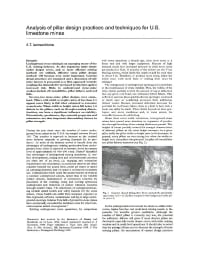Mining Publication: Analysis of Pillar Design Practices and Techniques for U.S. Limestone Mines
Original creation date: December 1999
Authors: AT Iannacchione
NIOSHTIC2 Number: 20022108
Inst Min Metall, Trans, Sect A: Min Ind, 1999 Dec 108():A152-A160
Underground stone mining is an emerging sector of the U.S. mining industry. As this expansion takes mines under deeper cover, and as more efficient mining methods are utilized, effective stone pillar design methods will become even more important. Current design practices are examined and a discussion of safe mine layouts is presented as a first approach towards weighing the demands for increased production against increased risk. Risks to underground stone-mine workers include rib instabilities, pillar failures and roof falls. Seventy-two stone-mine pillar designs were examined. Pillars with width to height ratios of less than 1.5 appear more likely to fail when subjected to excessive stress levels. When width to height ratios fall below 1.0, defects in the pillars, such as through-running discontinuities, can have a significant influence on stability. Discontinuity persistence, dip, material properties and orientation are also important determining factors in pillar strength.

NIOSHTIC2 Number: 20022108
Inst Min Metall, Trans, Sect A: Min Ind, 1999 Dec 108():A152-A160
- Advance and Relieve Mining: A Method to Mitigate the Effects of High Horizontal Stress on the Mine Roof
- Effects of Weak Bands on Pillar Stability in Stone Mines: Field Observations and Numerical Model Assessment
- Field Observations and Numerical Studies of Horizontal Stress Effects on Roof Stability in U.S. Limestone Mines
- Investigation of Pillar-Roof Contact Failure in Northern Appalachian Stone Mine Workings
- Pillar Design Issues for Underground Stone Mines
- Pillar Stability Issues Based on a Survey of Pillar Performance in Underground Limestone Mines
- Pillar Strength and Design Methodology for Stone Mines
- Roof Span Design for Underground Stone Mines
- Technique to Assess Hazards in Underground Stone Mines: the Roof Fall Risk Index (RFRI)
- Underground Stone Mine Pillar Design in Challenging Conditions